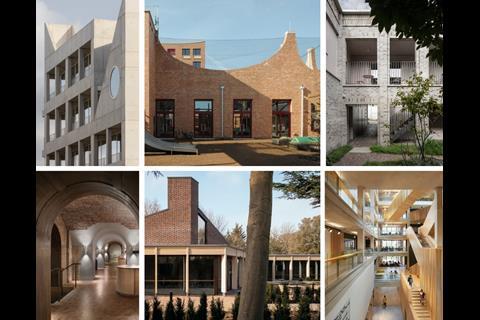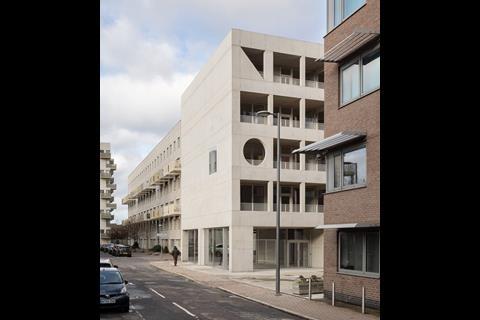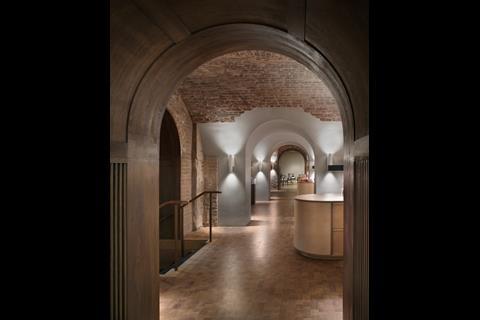Adam Khan, Sergison Bates and Apparata all debut in final round of the highest prize in British architecture
Half of the slots on the 2023 Stirling Prize shortlist have been snared by practices making their debut in the final round of the highest accolade in British architecture, RIBA has revealed.
Adam Khan Architects, Sergison Bates Architects and Apparata Architects are all first-timers in the endgame of the Stirling fray.
They are joined by 2013 winners Witherford Watson Mann Architects, Feilden Clegg Bradley Studios – which won in 2008 in conjunction with Alison Brooks Architects and Maccreanor Lavington, and Mæ Architects, which was shortlisted for the first time last year.
Critics are likely to point to the London-centric nature of the shortlist with all but one of the projects – FCBS’ University of Warwick Faculty of Arts – in London, and there are no shortlisted schemes from Scotland, Wales or Northern Ireland.
New RIBA president Muyiwa Oki said the projects on the 2023 shortlist, which range from infill social housing and community facilities to the reworking of the Courtauld Institute of Art, were an illustration of why architecture matters to everyone.
“These six remarkable buildings offer thoughtful, creative responses to the really complex challenges we’re facing today,” he said.
“Whether it’s tackling loneliness, building communities, or preserving our heritage, these projects lay out bold blueprints for purposeful architecture.
“Amidst a backdrop of housing shortages, growing inequality, and economic uncertainties, this year’s shortlist demonstrates that well-designed buildings can offer genuinely inspiring solutions to our most pressing problems.”

Apparata Architects’ A House for Artists in Barking, east London, is described by RIBA as “a model for affordable city living”. The apartment complex offers reduced-price housing to resident artists. In return, they deliver free creative programmes for the local community via a street-facing exhibition space.
The scheme features a permanent installation by Grayson Perry in the complex’s central courtyard.

Adam Khan Architects’ Central Somers Town Community Facilities and Housing, in Camden, north London, features social housing, an after-school club, an adventure playground and premises for a theatre-education charity. RIBA described the scheme as “playfully designed” spaces arranged around a small park.
Witherford Watson Mann’s Courtauld Connects project for the Courtauld Institute of Art is described as a mix of “careful conservation and bold interventions” to modernise a landmark 18th century building that features a warren of spaces.

RIBA said the practice’s “subtle interventions” included re-levelled floors and new doors to the main galleries. It said the project had “notably improved accessibility” and eased visitor flow at the institute, which is based at Somerset House in Westminster.
Mæ’s John Morden Centre at Blackheath, in south-east London, is described as delivering “elderly living without isolation”. The project has given a 300-year-old residential and nursing facility a new lease of life with treatment rooms, a hair salon, nail bar, events space and wellbeing facilities.
RIBA said the centre had been designed to encourage connection and movement among residents, supporting healthier and longer lives.

Sergison Bates Architects’ Lavender Hill Courtyard Housing in Clapham, south-west London, is described by RIBA as maximising a difficult urban space by “ingeniously” inserting new apartments into a “previously undesirable and highly constrained urban site”. It said those who progress beyond an “unassuming entrance” find a welcoming courtyard at the heart of the scheme that offers communal space for residents.

FCBS’ University of Warwick Faculty of Arts at Coventry is described by RIBA as using nature to create connections in higher education. The institute said surrounding parkland is “woven into” a building that unites the arts and humanities under one roof.
“A feature staircase, inspired by the structure of a tree, grows through the central atrium with each branch leading to flexible spaces designed to inspire collaboration and cross-pollination of the arts,” it said.

The winner of the Stirling Prize 2023 is due to be announced at a ceremony in Manchester on 19 October.
OMA partner Ellen van Loon is chair of the jury panel. Its members include 2022 winner Niall McLaughlin.
RIBA Stirling Prize Shortlist 2023
:: A House for Artists by Apparata Architects (Barking, London)
Flexible live/work space for 12 artists. In exchange for reduced rent, they deliver free creative programmes for the neighbourhood through a street-facing, glass-walled community hall and outdoor exhibition space.
:: Central Somers Town Community Facilities and Housing by Adam Khan Architects (Camden, London)
Part of a larger masterplan, this project includes a flexible community children’s facility, adventure playground and several homes for social rent.
:: Courtauld Connects – The Courtauld Institute of Art by Witherford Watson Mann Architects (London)
Part of a multi-phase project that aims to open up the institution both physically and culturally. This phase includes the reworking of the entrance, a beautiful new stair down to basement visitor facilities; and re-levelling and opening up the 18th century vaults.
:: John Morden Centre by Mæ (Greenwich, London)
Day centre for a later-living residential charity. The timber and brick building includes a medical centre, café, lounges and offices. A meandering timber spine forms an enclosed forest-like walkway stitching together a series of brick pavilions, expertly combining recreational and more tricky medical facilities without feeling institutional.
:: Lavender Hill Courtyard Housing by Sergison Bates Architects (Clapham, London)
Tucked away down a timber-lined passageway, barely visible at the end of a Clapham mews, Lavender Hill Courtyard has redeveloped a former sheet-metal workshop into nine apartments, arranged around a courtyard space and a timber-decked terrace on the first floor.
:: University of Warwick – Faculty of Arts, Feilden Clegg Bradley Studios (West Midlands)
An impressive new building that brings together the departments and schools of the arts faculty under a single roof for the first time. The new building draws inspiration from the site’s parkland context. Four pavilion buildings are connected by a feature staircase, inspired by the structure of a tree, that organically grows through the central atrium space, each branch helping to demarcate various communal spaces to encourage cross-disciplinary collaboration. At the base of the stair, it splays to form an amphitheatre that activates the ground floor and addresses the main entrance.









































No comments yet